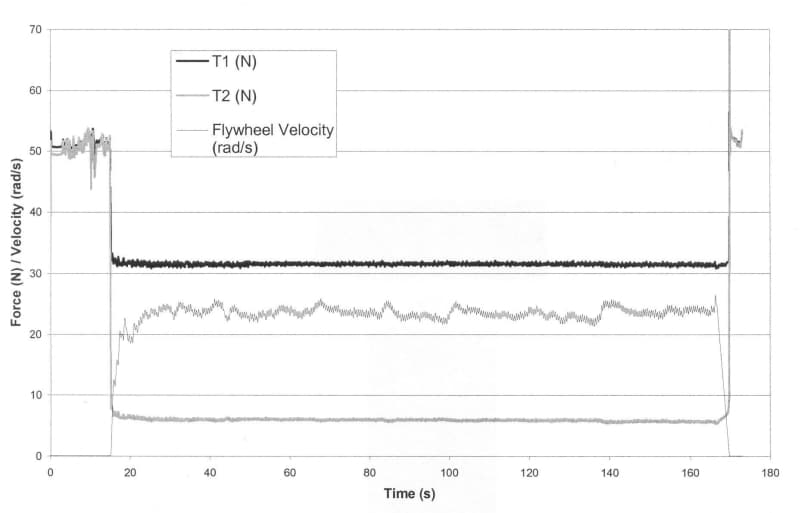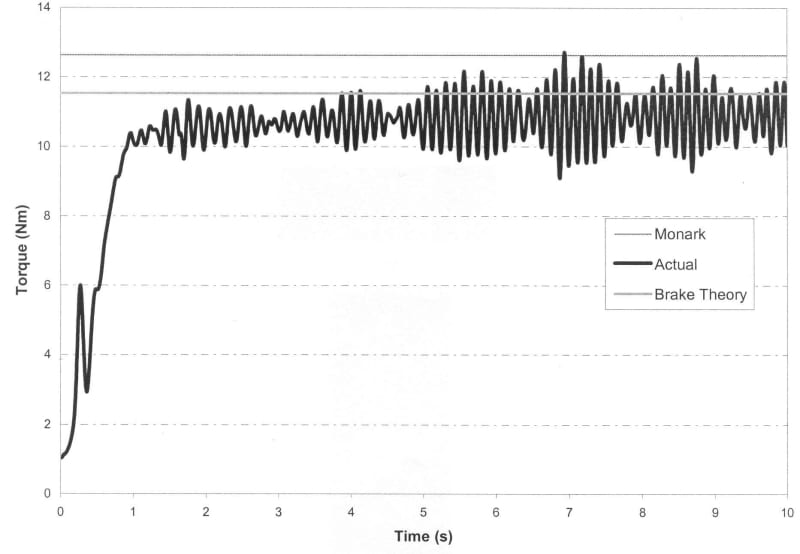The Monark rope-braked ergometer is widely used by physiologists to determine the work and power output from subjects or for physiological measurements to be made at a predetermined level of effort. The power is determined by taking the product of the pedal rate (rpm) and the brake mass (kg). The brake mass is suspended in a basket attached to a pulley. A rope is connected to the pulley and is wound around the ergometer flywheel to provide resistance. MacIntosh et al. (2002) directly measured the rope tension and found that the tight and slack side tensions were 95.5% and 6.71% of the applied load. These results contradict the traditional assumption that the slack side tension is zero. There is, however, a discrepancy in these results as the moments applied to the pulley are not in equilibrium. Gordon et al. (2004) give a detailed theoretical analysis of the brake system and validated the theory with experimental results. The ratio of tension in the rope is given by, T1/T2=eμθ where T1 is the tight side tension (N), T2 the slack side tension (N), μ is the coefficient of friction and θ is the angle of lap (radians). It is difficult to obtain values for the coefficient of friction to determine the theoretical brake load and hence direct measurement of the rope tension was used. Figure 1 shows the measured tensions and the flywheel velocity of a subject pedalling against a resistance of 3kg at a constant velocity. This shows that prior to and at the end of the subject pedalling the tight and slack side tensions are equal. Therefore, the forces on the flywheel are in equilibrium. During the period when the subject is pedalling both the tight and slack side tension is reduced but remains constant. The tight side tension is 32.3N (SD 0.19) and the slack side tension is 5.92N (SD 0.17). This gives a brake load of 26.38N compared with the value of 29.43N, which would be traditionally used. This is an error of 10.4%. This error is then carried into the calculations of brake torque, work done and power. Figure 2 shows the directly measured brake torque for a Wingate Anaerobic Test (WAnT) and compares it with the theoretical brake torque and that assumed by Monark (Constant). This shows that far from being constant the brake torque varies during this test. The error is increased as the moment of inertia of the flywheel is calculated using an inaccurate measure of the brake torque. In conclusion the oversimplification in the analysis of the brake system leads to an overestimation of the work and power generated. In tests that use the brake torque to determine the moment of inertia of the flywheel the error is compounded.
University of Bristol (2005) J Physiol 567P, C135
Oral Communications: Engineering implications on physiological measurements using a Monark rope braked ergometer
Gordon, Rae Stephen; Franklin, Kathryn; Baker, Julien; Davies, Bruce;
1. School of Technology, University of Glamorgan, Trefforest, RCT, United Kingdom. 2. School of Applied Science, University of Glamorgan, Trefforest, United Kingdom.
View other abstracts by:
Tight (T1) and slack side (T2) rope tensions and flywheel velocity for a subject pedalling against a 3kg resistance.
Comparison of directly measured brake torque (actual) for a Wingate Anerobic Test with the rope brake theory and Monark values.
Where applicable, experiments conform with Society ethical requirements.


